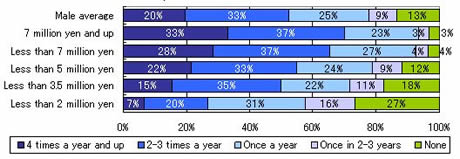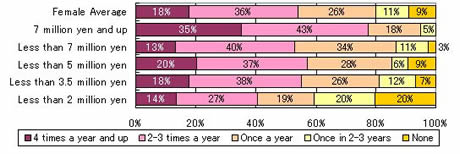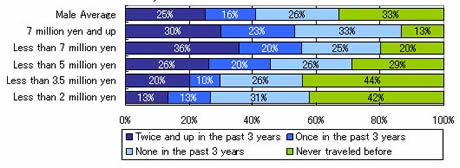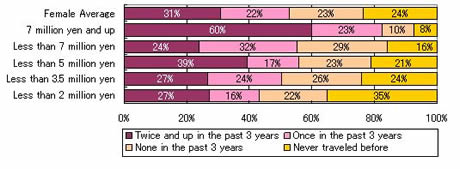JTM’s Survey Result: Consumption and Travel Trends for Japanese Youth in Their Twenties (Part 2)
Young overseas travelers are on decrease. One of the major factors is said to be decreased disposable income among young people. Then, do the youth with a higher income travel more frequently? A recent survey on income and frequency of travel reveals.

Mayuko Kono Executive officer / Lead Consultant
The recent JTM survey on consumption and travel trends for Japanese youth in their twenties reveals that “traveling” turns up to be a priority if respondents would have disposable 300,000 yen with them. For youth in their twenties 300,000 yen can be a viable amount of money either to save up or to receive as bonus. The survey result shows that 300,000 yen is the amount of money that motivates respondents to take domestic travel.
Approximately 80% (female 80%, male78%) of the entire respondents in their twenties take domestic leisure travel at least once a year in the last three years. Around half of them travel more than twice a year. Domestic travel appears to be common activity for Japanese youth in their twenties. There are several reasons to it. First, Japan has abundant tourism resources such as hot spring and local food. Second, domestic travel is comparatively easy to schedule or re-schedule in accordance with one’s budget and holidays as well as to adjust the itinerary among persons traveling together. Third, in contrast to overseas travel, domestic travel requires less concern about language, safety & security and sanitary conditions. These factors make the youth feel domestic travel easy to participate.
Looking at travel trend according to respondents’ household annual income level, a visible contrast lies between male and female. In case of male, the higher income one makes the more frequently one travels domestically. In the meantime, more than 40% of female respondents with low income (less than 2 million yen per year) travel domestically twice or three times a year, which is more frequent than male belonging to the same income group. Among those whose annual household income is between 2 -7 million yen, there is little difference in travel frequency. Male and female respondents with high income (7+ million yen) travel quite often. Frequency of women traveling abroad depends largely on whether or not their annual household income exceeds 7 million yen.
The proportion of respondents, male and female, who have no overseas travel experience, tends to be low among higher income group. However, male respondents with higher income (7+ million yen) travel less frequently than male belonging to the income group between 5 -7 million yen. As for female, travel frequency is lower in the income group between 5 -7 million yen compared to that of 5 million yen and less. The proportion is much higher among female respondents with 7+ million yen.
Frequency of overseas travel among young Japanese is in correlation with their annual household income level. However, as their income is higher, male seem to travel less frequently possibly because they are busier with work. And young married female might be too busy with child rearing. In result, it may not be appropriate to generalize that differences in annual household income is the only decisive factor for frequency of overseas travel by young Japanese.
The report continues to further analyze travel trends among young Japanese in their twenties to identify the obstacles for them to make domestic and overseas travel.
Frequency of domestic travel for tourism purpose in the past three years
(by annual household income/male)

Frequency of domestic travel for tourism purpose in the past three years
(by annual household income/female)

Frequency of overseas travel for tourism purpose in the past three years
(by annual household income/male)

Frequency of overseas travel for tourism purpose in the past three years
(by annual household income/female)

Source:
Japan Tourism Marketing Co.2008 “Survey on Consumption and Travel Trends for Japanese Youth in Their Twenties”
Surveyees: Male and Female in their twenties residing in the Tokyo Metropolitan, Central and Kansai area in Japan
